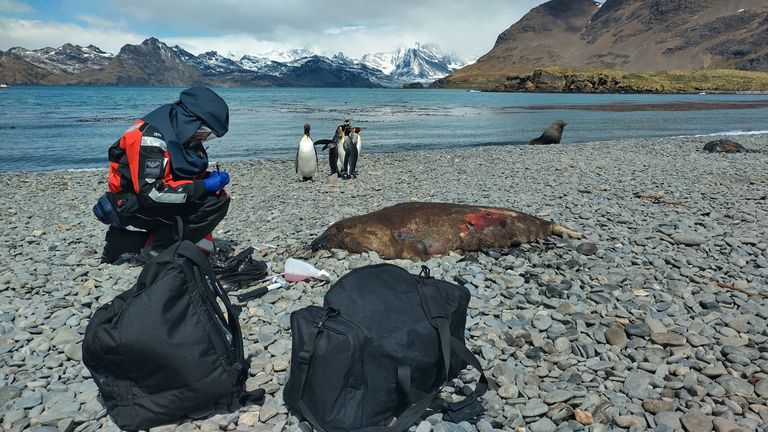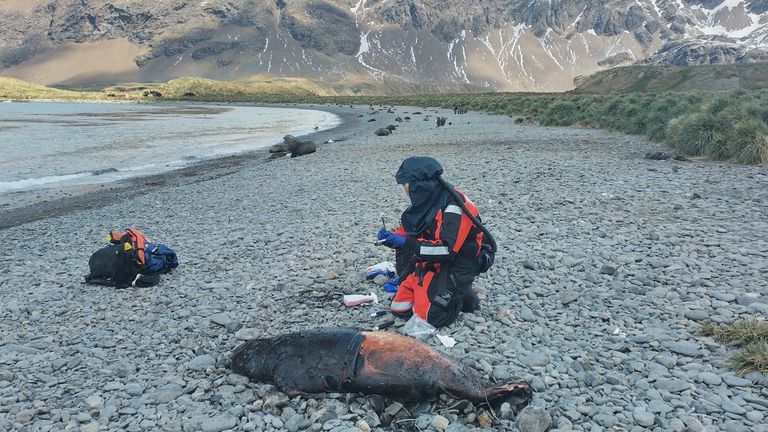Highly infectious form of bird flu confirmed for first time in Antarctic seals | Science & Tech News

A highly infectious form of bird flu has been confirmed for the first time in Antarctic seals, threatening one of the most fragile ecosystems on the planet.
Scientists working for the UK’s Animal Plant Health Agency (APHA) detected the variant of the H5N1 virus in samples taken from dead elephant and fur seals on the sub-Antarctic island of South Georgia.
Dozens of animals are known to have died, with many more likely to have succumbed in remote bays and out at sea.
Experts at British Antarctic Survey told Sky News that the unfolding tragedy was a “mass mortality event”.
Dr Marco Falchieri, from the APHA, spent three weeks collecting samples from wildlife on South Georgia, a UK Overseas Territory in the Southern Ocean.
Pic: APHA
He said seals and seabirds share the same beaches, giving the virus a chance to transmit.
“It is significant because this level of mortality is not normally seen in this population,” he said.
“The fact that we found the virus suggests that it is responsible for the casualties that have been seen.”
Virus has swept the globe
The 2.3.4.4b form of the virus has swept the globe, spread by migrating birds. It has caused mass die-offs in several seabird colonies in the UK.
Any movement of the virus between birds and mammals is a concern to scientists who closely monitor ‘spillover events’ for any sign that it is mutating.
It’s thought to have killed thousands of sealions around South America, as well as large numbers of mink and foxes being farmed for fur in Europe. It has been detected in a small number of mammals in the UK, including seals and wild foxes.
But there’s no good evidence that the virus is spreading between mammals and the APHA scientists found no indication that the virus had adapted to surviving in seals.
These animals share the same environment with birds,” said Dr Falchieri.
Read more:
Third set of vaccines for foie gras ducks to try to halt bird flu outbreak
Hope in fight against lethal bird flu
Nearly 10,000 seabirds dead and sick across Scotland
“That’s the way we think these animals have been infected by the virus.”
Conservationists had hoped the vast Southern Ocean would stop the virus reaching Antarctica and South Georgia, but it was detected in October in corpses of brown skua, a large seabird.
‘Big relief’ for Antarctic penguins, for now
The new research by the APHA has also found the virus in kelp gulls and Antarctic terns, but so far it hasn’t been seen in penguins.
Professor Ashley Banyard, an avian influenza specialist at the APHA, told Sky News: “It’s a big relief to a lot of us that the penguins haven’t been affected.

Curious penguins check out Dr Falchieri. Pic: APHA
“We don’t know whether that’s because there’s a lack of susceptibility, or that they’ve had prior exposure and some antibody response to a less pathogenic virus that may well have travelled asymptomatically in migrating birds.”
But penguins have been affected in other parts of the world and wildlife experts fear the consequences of the virus reaching the Antarctic continent itself.
Norman Ratcliffe, a seabird ecologist at British Antarctic Survey said: “These are mass mortality events at a well above the baseline levels.
“If the virus does establish on the continent it could potentially spread right around.

Pic: APHA
“That would affect the global population of Emperor penguins and a very large proportion of the world’s Adelie penguins as well.
“Leopard, crabeater and Weddell seals could also be infected.
“These are all species that really aren’t found anywhere else, so this would have global repercussions on Antarctic wildlife.”
Many Antarctic species are already struggling as the climate changes and sea ice retreats.
Recent Posts
- Clia unveils benefits and events as it opens 2025 membership
- Pullman Hotels & Resorts reveals the ultimate blended travel space – The Transforming Room
- World of Hyatt and Headspace Launch New Series to Help Travelers Find A Good Night’s Sleep
- Influencers signed up as Abta kicks off pre-peaks promotion
- Peter Island Resort Set for December Debut in the British Virgin Islands






Recent Comments